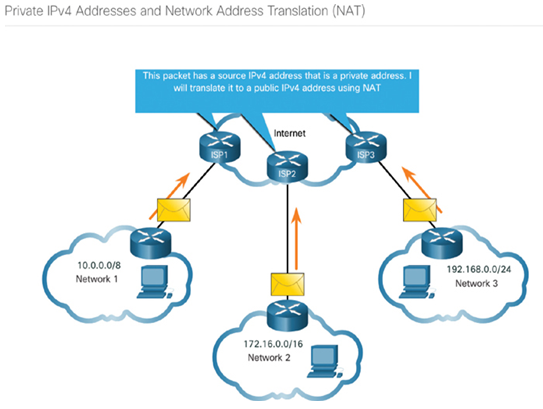Most internal networks, from large enterprises to home networks, use private IPv4 addresses for addressing all internal devices (intranet) including hosts and routers. However, private addresses are not globally routable.
In Figure 9-4, customer networks 1, 2, and 3 are sending packets outside their internal networks. These packets have a source IPv4 address that is a private address and a destination IPv4 address that is public (globally routable). Packets with a private address must be filtered (discarded) or translated to a public address before forwarding the packet to an ISP.

Figure 9-4 Private IPv4 Addresses Translated to Public IPv4 Addresses
Before the ISP can forward this packet, it must translate the source IPv4 address, which is a private address, to a public IPv4 address using Network Address Translation (NAT). NAT is used to translate between private IPv4 and public IPv4 addresses. This is usually done on the router that connects the internal network to the ISP network. Private IPv4 addresses in the organization’s intranet will be translated to public IPv4 addresses before routing to the internet.
Special Use IPv4 Addresses (9.2.4)
There are certain addresses, such as the network address and broadcast address, that cannot be assigned to hosts. There are also special addresses that can be assigned to hosts, but with restrictions on how those hosts can interact within the network.
Loopback addresses (127.0.0.0 /8 or 127.0.0.1 to 127.255.255.254) are more commonly identified as only 127.0.0.1. These are special addresses used by a host to direct traffic to itself. For example, the ping command is commonly used to test connections to other hosts. But you can also use the ping command to test if the IP configuration on your own device, as shown in Example 9-1.
Note
You will learn more about the ping command later in this course.
Example 9-1 Pinging the Loopback Interface
C:\Users\NetAcad>
ping 127.0.0.1
Pinging 127.0.0.1 with 32 bytes of data:
Reply from 127.0.0.1: bytes=32 time<1ms TTL=128
Reply from 127.0.0.1: bytes=32 time<1ms TTL=128
Reply from 127.0.0.1: bytes=32 time<1ms TTL=128
Reply from 127.0.0.1: bytes=32 time<1ms TTL=128
Ping statistics for 127.0.0.1:
Packets: Sent = 4, Received = 4, Lost = 0 (0% loss),
Approximate round trip times in milli-seconds:
Minimum = 0ms, Maximum = 0ms, Average = 0ms
C:\Users\NetAcad>
ping 127.1.1.1
Pinging 127.1.1.1 with 32 bytes of data:
Reply from 127.1.1.1: bytes=32 time<1ms TTL=128
Reply from 127.1.1.1: bytes=32 time<1ms TTL=128
Reply from 127.1.1.1: bytes=32 time<1ms TTL=128
Reply from 127.1.1.1: bytes=32 time<1ms TTL=128
Ping statistics for 127.1.1.1:
Packets: Sent = 4, Received = 4, Lost = 0 (0% loss),
Approximate round trip times in milli-seconds:
Minimum = 0ms, Maximum = 0ms, Average = 0ms
C:\Users\NetAcad>
Link-Local addresses
Link-local addresses (169.254.0.0 /16 or 169.254.0.1 to 169.254.255.254) are more commonly known as the Automatic Private IP Addressing (APIPA) addresses or self-assigned addresses. They are used by a Windows client to self-configure in the event that the client cannot obtain an IP addressing through other methods. Link-local addresses can be used in a peer-to-peer connection but are not commonly used for this purpose.
